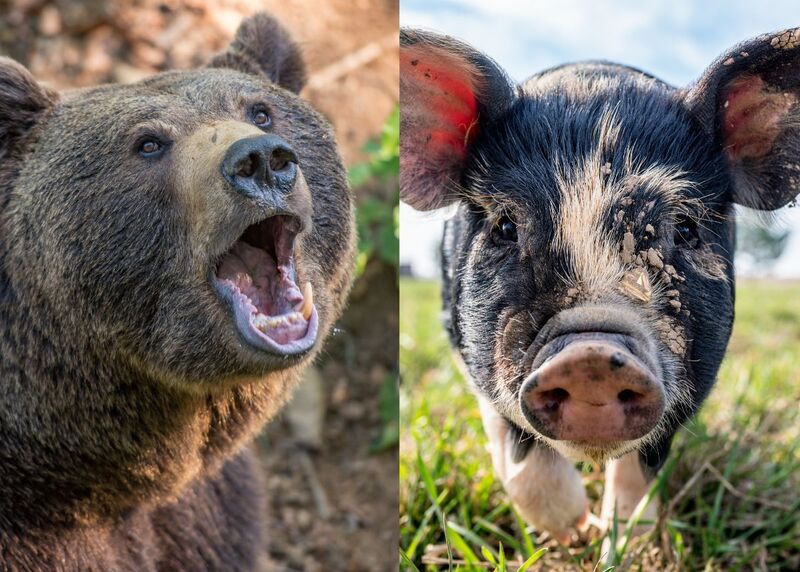At first glance, bears and pigs seem worlds apart—the bear, a massive carnivore, and the pig, a smaller omnivore, appear to share little in common. However, evolutionary biology offers surprising insights into their distant connections.
Here’s a quick answer to the question: While bears and pigs share a common ancestor as placental mammals, they belong to distinct orders and have followed divergent evolutionary paths over the past 65 million years. In short, bears and pigs are not closely related.

Taxonomy classifies organisms based on observable traits, while phylogenetics delves deeper by examining genetic similarities to map evolutionary relationships. Through detailed phylogenetic trees, scientists identify where species diverged from common ancestors. While physical traits may suggest connections, genetic evidence often reveals surprising evolutionary pathways.
For instance, molecular studies show pigs share more DNA with whales than with other even-toed ungulates like deer or cattle. Similarly, while a bear cub may superficially resemble a piglet, genetic studies confirm that bears are closer to seals and dogs than to pigs.
These findings remind us not to judge evolutionary relationships solely by appearances.
The earliest bear ancestors appeared about 38 million years ago during the Eocene epoch. These ancestors belonged to two subfamilies: Amphicynodontinae (“primitive dog-like bears”) and Hemicyoninae (“half-dog-like bears”).
Amphicynodontinae (38–22 million years ago): Small, tree-dwelling mammals, primarily herbivorous.
Hemicyoninae (32 million years ago): Larger, ground-dwelling predators.
By the Miocene epoch (20–5 million years ago), these subfamilies evolved into modern bear lineages, including ancestors of pandas, cave bears, and spectacled bears.
Bears belong to the order Carnivora and are closely related to dogs, raccoons, and seals. Genetic evidence suggests their family, Ursidae, diverged about 43 million years ago. Meanwhile, pigs, part of the order Artiodactyla, evolved alongside even-toed ungulates like deer and hippos.
Bears adapted as omnivores, developing powerful limbs, sharp claws, and strong jaws for hunting and foraging. In contrast, pigs evolved snouts for rooting in soil and continuously growing teeth for grinding plants.
Pigs trace their origins back 65 million years to small, hoofed mammals related to hippos and whales. These ancestors, known as anthracotheres, diversified into various genera and adapted to changing environments.
By the Eocene epoch (40 million years ago), anthracotheres evolved into early pig-like mammals called entelodonts. These omnivores, nicknamed "hell pigs," could weigh over 2,000 pounds and supplemented their diets with meat.
Modern pigs emerged during the Oligocene epoch (35 million years ago) and rapidly diversified. By the Miocene epoch, genera like Sus (wild boars) evolved, leading to today’s domestic pigs. Wild boars (Sus scrofa) originated in Southeast Asia and spread across Eurasia, adapting to diverse environments.
Pigs were domesticated independently in the Fertile Crescent and China 8,000–10,000 years ago. Traits like rapid growth and docility were selectively bred, resulting in today’s highly adaptable domestic pigs.
Bears and pigs share a distant carnivorous ancestor from over 65 million years ago. Their evolutionary paths split as early bears adapted to temperate climates and omnivorous diets, while pigs evolved in tropical regions with herbivorous tendencies.
This divergence shaped their physical traits: bears retained large bodies and sharp teeth for hunting, while pigs developed snouts and molars suited for rooting and grinding plant material.
Bears: Evolved for cold climates with thick fur, camouflage, and hibernation capabilities.
Pigs: Adapted to warmer environments with sparse fur, sweat glands, and social structures.
While bears became apex predators requiring intelligence and hunting skills, pigs thrived in social groups, foraging opportunistically.
Bears are omnivores, consuming plants, berries, and meat, including large prey like deer. Pigs, though omnivorous, favor plants and forage by rooting in soil for fungi and roots.
These dietary differences reflect their ecological roles: bears as solitary predators and pigs as social foragers. Bears’ intelligence supports hunting across vast territories, while pigs’ sensory abilities aid localized foraging.
Bears inhabit forests, tundra, and mountains, requiring large, undisturbed territories. In contrast, pigs thrive in diverse habitats, including human-modified environments, due to their high reproductive rates.
Although bears and pigs share a distant common ancestor, their evolutionary paths diverged millions of years ago. Bears evolved as solitary omnivores and apex predators, while pigs became social omnivores thriving in varied environments.
These differences illustrate the remarkable adaptability of mammals and how diet, climate, and geography shape evolutionary outcomes. Understanding these distinctions helps us appreciate the complexity of nature’s family tree.
We created this article in conjunction with AI technology, then made sure it was fact-checked and edited by a Animals Top editor.